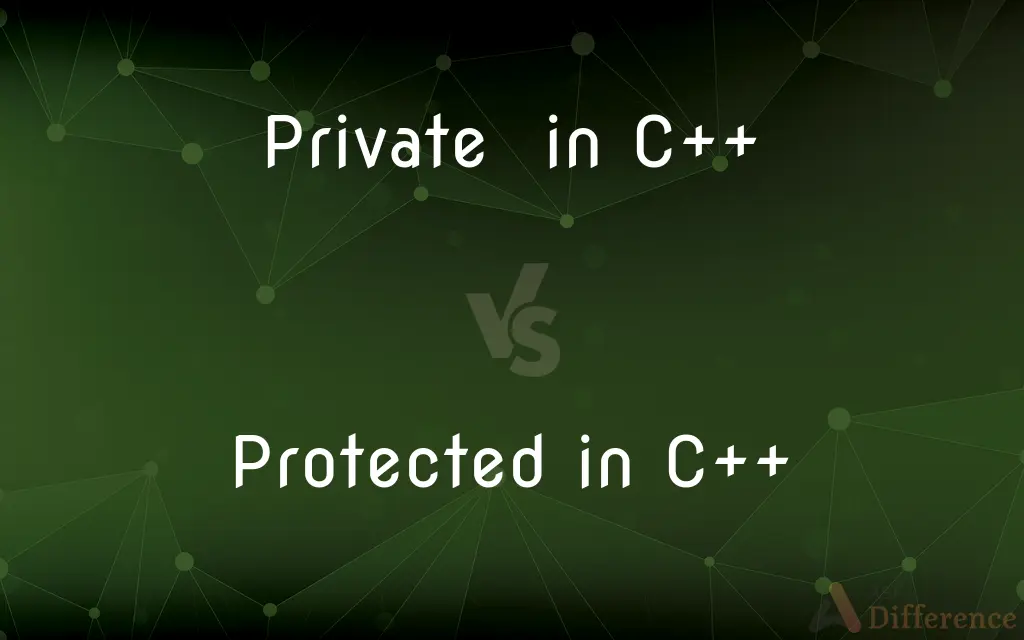Private in C++ vs. Protected in C++ — What's the Difference?
By Tayyaba Rehman — Published on January 5, 2024
Private members in C++ are accessible only within the same class, while protected members are accessible within the same class and its subclasses.

Difference Between Private in C++ and Protected in C++
Table of Contents
ADVERTISEMENT
Key Differences
In C++, private members of a class are only accessible within the class itself, ensuring encapsulation and hiding of data. On the other hand, protected members are not only accessible within the class but also in its derived classes, offering a more flexible form of data protection.
Private access specifier in C++ strictly restricts access to class members, making it ideal for sensitive data. In contrast, protected access allows inheritance hierarchies to share class features more freely while still restricting public access.
When using private access, external functions or classes, including derived classes, cannot access the private members. In comparison, with protected access, derived classes can utilize and modify these members, fostering polymorphic behavior.
The private specifier in C++ is a fundamental tool for object-oriented programming, ensuring internal class mechanisms remain hidden. Conversely, protected access plays a crucial role in subclassing, allowing for an extended functionality while maintaining control over access.
Private members in C++ uphold the principle of least privilege, limiting exposure. Protected members, while also limiting exposure, provide a pathway for extended class functionality through inheritance.
ADVERTISEMENT
Comparison Chart
Access Scope
Accessible only within the class itself.
Accessible within the class and its subclasses.
Inheritance
Not accessible in derived classes.
Accessible and modifiable in derived classes.
Encapsulation
Offers high level of data encapsulation.
Offers a balanced level of data encapsulation and flexibility.
Suitability
Ideal for sensitive or internal data.
Suitable for data and methods intended for use in subclasses.
Design Principle
Upholds strict data hiding as per object-oriented principles.
Facilitates polymorphism and extended functionality in inheritance hierarchies.
Compare with Definitions
Private in C++
Private members are exclusive to the class they are defined in.
In class Car, a private method startEngine() cannot be called from outside the class.
Protected in C++
Protected access allows inheritance hierarchies to share functionalities.
In class Animal, a protected attribute age can be directly used by its subclass Dog.
Private in C++
Private is the default access level for class members.
In class Bicycle, a method pedal() without an access specifier is treated as private.
Protected in C++
Protected members are not accessible from outside the class hierarchy.
Attempting to access a protected method updateFirmware() from outside the Gadget class hierarchy results in an error.
Private in C++
Private access specifier ensures strict data encapsulation.
A private variable engineSpeed in class Vehicle cannot be accessed directly by a Truck class that inherits Vehicle.
Protected in C++
Protected access specifier supports polymorphism in class hierarchies.
A protected virtual method draw() in Shape can be overridden in its subclass Circle.
Private in C++
Private access restricts the use of members to the defining class only.
A private method calculateFuelEfficiency() in Motorcycle class cannot be accessed from a friend class MotorcycleTester.
Protected in C++
Protected members provide a balance between encapsulation and accessibility.
In UserAccount, a protected method logActivity() can be utilized by its subclass AdministratorAccount.
Private in C++
Private members cannot be accessed by derived classes.
In a subclass SportsCar of Car, accessing a private member maxSpeed of Car results in a compile-time error.
Protected in C++
Protected members are accessible in the class and its derived classes.
A protected method adjustSettings() in class Device can be called in its subclass Smartphone.
Common Curiosities
Do private members participate in inheritance?
Private members are inherited but remain inaccessible to the subclass.
Are protected members accessible in the same class?
Yes, protected members are accessible in the same class.
Can a friend function access private members?
Yes, a friend function can access private members.
Are private constructors inheritable?
Private constructors are inheritable but cannot be called in derived classes.
Is it possible to change the access level of inherited protected members?
Yes, the access level of inherited protected members can be changed in subclasses.
Can private members be accessed in subclasses?
No, private members cannot be accessed in subclasses.
Is it possible to access protected members from outside the class?
No, protected members cannot be accessed from outside the class.
What is the default access level for class members?
The default access level in classes is private.
Can protected members be accessed by objects of the same class?
Yes, protected members can be accessed by objects of the same class.
Can protected members be accessed using base class pointers?
Protected members can be accessed using pointers if the pointer type is of the derived class.
Can protected members be overridden in derived classes?
Yes, protected members can be overridden in derived classes.
How does private access affect encapsulation?
Private access enhances encapsulation by hiding class internals.
Are private members visible to friend classes?
Yes, private members are visible to friend classes.
Can private members be accessed by instances of the same class?
Yes, private members can be accessed by instances of the same class.
How does protected access affect class design?
Protected access facilitates subclassing and polymorphism.
Share Your Discovery

Previous Comparison
Binary Tree vs. Binary Search Tree
Next Comparison
Simple Leaves vs. Compound LeavesAuthor Spotlight
Written by
Tayyaba RehmanTayyaba Rehman is a distinguished writer, currently serving as a primary contributor to askdifference.com. As a researcher in semantics and etymology, Tayyaba's passion for the complexity of languages and their distinctions has found a perfect home on the platform. Tayyaba delves into the intricacies of language, distinguishing between commonly confused words and phrases, thereby providing clarity for readers worldwide.
















































